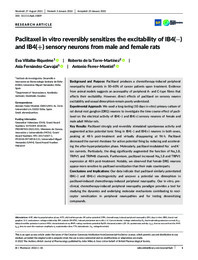Por favor, use este identificador para citar o enlazar este ítem:
https://hdl.handle.net/11000/34368
Paclitaxel in vitro reversibly sensitizes the excitability of IB4(-) and IB4(+) sensory neurons from male and female rats
Título :
Paclitaxel in vitro reversibly sensitizes the excitability of IB4(-) and IB4(+) sensory neurons from male and female rats |
Autor :
Fernandez-Carvajal, Asia 
Villalba Riquelme, Eva María 
de la Torre-Martinez, Roberto 
Ferrer-Montiel, Antonio  |
Editor :
Wiley |
Departamento:
Departamentos de la UMH::Bioquímica y Biología Molecular |
Fecha de publicación:
2022 |
URI :
https://hdl.handle.net/11000/34368 |
Resumen :
Background and Purpose: Paclitaxel produces a chemotherapy-induced peripheral
neuropathy that persists in 50–60% of cancer patients upon treatment. Evidence
from animal models suggests an axonopathy of peripheral A- and C-type fibres that
affects their excitability. However, direct effects of paclitaxel on sensory neuron
excitability and sexual dimorphism remain poorly understood.
Experimental Approach: We used a long-lasting (10 days in vitro) primary culture of
rat dorsal root ganglion (DRG) neurons to investigate the time course effect of paclitaxel
on the electrical activity of IB4( ) and IB4(+) sensory neurons of female and
male adult Wistar rats.
Key Results: Paclitaxel strongly and reversibly stimulated spontaneous activity and
augmented action potential tonic firing in IB4( ) and IB4(+) neurons in both sexes,
peaking at 48 h post-treatment and virtually disappearing at 96 h. Paclitaxel
decreased the current rheobase for action potential firing by reducing and accelerating
the after-hyperpolarization phase. Molecularly, paclitaxel modulated Na+ and K+
ion currents. Particularly, the drug significantly augmented the function of Nav1.8,
TRPV1 and TRPM8 channels. Furthermore, paclitaxel increased Nav1.8 and TRPV1
expression at 48 h post-treatment. Notably, we observed that female DRG neurons
appear more sensitive to paclitaxel sensitization than their male counterparts.
Conclusions and Implications: Our data indicate that paclitaxel similarly potentiated
IB4( ) and IB4(+) electrogenicity and uncover a potential sex dimorphism in
paclitaxel-induced chemotherapy-induced peripheral neuropathy. Our in vitro, preclinical,
chemotherapy-induced peripheral neuropathy paradigm provides a tool for
studying the dynamics and underlying molecular mechanisms contributing to nociceptor
sensitization in peripheral neuropathies and for testing desensitizing
compounds.
|
Palabras clave/Materias:
cancer
ion channel
neuropathy
nociceptor
pain
sexual dimorphism
thermoTRP |
Área de conocimiento :
CDU: Ciencias puras y naturales: Biología: Bioquímica. Biología molecular. Biofísica |
Tipo de documento :
info:eu-repo/semantics/article |
Derechos de acceso:
info:eu-repo/semantics/openAccess
Attribution-NonCommercial-NoDerivatives 4.0 Internacional |
DOI :
https://doi.org/10.1111/bph.15809 |
Publicado en:
British Journal of Pharmacology |
Aparece en las colecciones:
Artículos - Bioquímica y Biología Molecular
|
 La licencia se describe como: Atribución-NonComercial-NoDerivada 4.0 Internacional.
La licencia se describe como: Atribución-NonComercial-NoDerivada 4.0 Internacional.
 La licencia se describe como: Atribución-NonComercial-NoDerivada 4.0 Internacional.
La licencia se describe como: Atribución-NonComercial-NoDerivada 4.0 Internacional.
.png)
